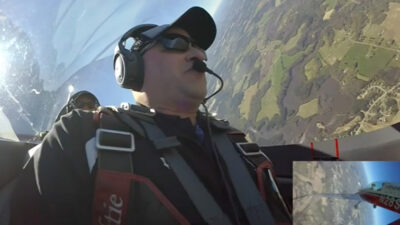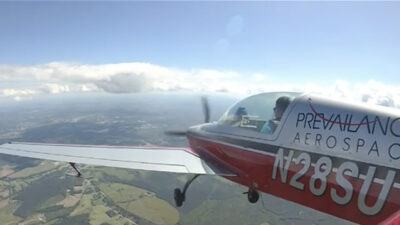Training to “Startle”
The “Startle” response, common to all mammals, reptiles, fish, and humans – including pilots of any and every skill or experience level, is an innate and involuntary reaction to sudden or threatening stimuli. Triggered by disturbing and unexpected events, our reaction is reflexive, the result of a defense mechanism that is deeply imprinted in the DNA of all vertebrates. Nowhere in the aviation experience is this more prevalent than Loss of Control In-Flight (LOC-I) or during aircraft upset events. Pilots often instantly react in one of three ways: fight, flight, or freeze. More often than not, this results in applying insufficient or incorrect recovery techniques with all too often catastrophic results.
LOC-I is unchallenged as the leading cause of aviation fatalities, and subsequent mishap investigations frequently acknowledge Startle as a causal factor. Fortunately, it doesn’t have to be this way. When a pilot is properly trained, the Startle reflex can be minimized and its effects significantly mitigated.
It is critical that pilots understand the basic physiological processes that occur in their brains and bodies when experiencing Startle. On-aircraft UPRT directly addresses Startle to effectively enhance a pilot’s ability to safely and effectively counter its effect. The ultimate goal of this training is to reduce a pilot’s level of impairment, and duration of impairment, following an aircraft upset or LOC-I situation.
UPRT should not be focused solely on aerobatics and spins. UPRT should not be about “pulling Gs” or channeling your inner Red Bull racer. UPRT that concentrates only on “stick and rudder” training is, quite simply, insufficient and incomplete. Rather, effective UPRT is focused on understanding energy relationships and what is referred to as “brain training.” This brain training emphasizes controlled, physiological exposure to increasing levels of stimuli (e.g. unusual attitudes) to gradually reduce Startle magnitude and impairment time.
UPRT should, however, be a focused evolution with specific exposure and learning objectives for each flight. This training should occur with an FAA-approved UPRT provider, and it must be in an aircraft capable of withstanding the forces generated as a result of an individual pilot’s unpredictability. It’s important to realize that while flight characteristics vary from platform to platform, the laws of physics and aerodynamics are absolute.
Remember, no pilot is immune to Startle. According to Human Factors psychologist Jo-Anne Hamilton, two systems in the brain—the reflexive fast system and the slow system—play different roles in our reaction to perceived danger. The reflexive fast system acts immediately—in one twelfth of a second—by sending information directly to the sense organs through the thalamus, and on to the amygdala. The body automatically responds with increased activity such as:
- Circulation increasing blood supply to brain, muscles and to limbs (more O2)
- Brain activity changes: we think less and react more instinctively
- Heart beats quicker and harder, coronary arteries dilate
- Blood pressure rises
- Lungs take in more oxygen and release more CO2
- Liver releases extra sugar for energy
- Muscles tense for action
- Sweating increases to speed heat loss
- Adrenal glands release adrenalin to fuel response
The slow system sends sensory information to the hippocampus and cortex for further evaluation. It’s slower because it requires conscious processing.3
Australia’s Griffith University conducted research focused on individual, crew and organizational strategies for managing Startle. Their research revealed that a pilot’s conscious processing during a Startle event can be impaired for up to 30 seconds, with corresponding psychomotor impairment for up to ten seconds.4 These facts are further reinforced from a study conducted by Steve Casner, a research psychologist at NASA’s Ames Research Center, along with airline pilot collaborators, Richard Geven and Kent Williams. The research trio presented 18 active Boeing 747 pilots with in-flight emergencies that matched emergencies practiced during training. The test revealed that all 18 pilots “performed impeccably, providing the correct response for each emergency.”5 However, when the researchers incorporated situations that differed from those typically used in training, and presented the emergencies in ways that pilots had not yet encountered, they frequently “struggled or made critical errors.” 5 The goal of effective on-aircraft UPRT is to provide atypical training to enhance the “slow system” referenced by Hamilton, through repetition and exposure, to ultimately decrease peak impairment levels and impairment time.
On-aircraft, specific and recurrent UPRT is critical to countering a pilot’s peak impairment level and duration of impairment associated with an aircraft upset. Even with enhanced visuals and limited motion, a simulator cannot replicate the forces and psychological/physiological exposure experienced during on-aircraft UPRT. If properly briefed, executed, and debriefed, this training could provide the necessary skills to save lives should the unexpected occur, and might just be the most rewarding and enjoyable aviation training available.
References
- Prevailance Aerospace Safety Academy, 2016, Introduction to On-Aircraft UPRT, http://prevailanceaerospace.com/index.php?option=com_content&view=article&id=71
- Martin, W., Murray, P. and Bates, P. (2012). “The Effects of Startle on Pilots During Critical Events: A Case Study Analysis.” http://www98.griffith.edu.au/dspace/bitstream/handle/10072/54072/82496_1.pdf?sequence=1
- Flight Safety Australia (2015). “Without Warning: The Startle Factor”, Flight Safety Australia (2015). “Without Warning: The Startle Factor” http://www.flightsafetyaustralia.com/2015/08/without-warning-the-startle-factor/
- Griffith University, “Managing Startle: Individual, Crew and Organizational Strategies” http://www.icao.int/Meetings/LOCI/Presentations/Managing%20Startle%20Individual%20Crew%20and%20Organizational%20Strategies.pdf
- S. M. Casner, R. W. Geven, K. T. Williams. “The Effectiveness of Airline Pilot Training for Abnormal Events.” http://journals.sagepub.com/doi/10.1177/0018720812466893
- Science Daily, January 14, 2015, “How prepared is your pilot to deal with an emergency?”, https://www.sciencedaily.com/releases/2015/01/150114202755.htm

Prevailance Aerospace is a UPRT provider that has been working with corporate, government, and general aviation pilots to improve safety in the aviation industry. Prevailance Aerospace uses Extra 300 Series Aircraft for training and our pilots are experienced aviation professionals from various military and general aviation backgrounds. We know that successful aviation endeavors are accomplished through an uncompromising commitment to safety, impeccable professionalism, tremendous attention to detail, and constant improvement.
http://www.prevailanceaerospace.com
© 2025 Prevailance Aerospace. All Rights Reserved.
Next ArticleRelated Posts

Rise Up for the Next Generation
There is no doubt in my mind that flying is the way mankind is meant to travel, yet the continued success and growth of the industry requires a refined approach to safety. As someone who flies commercially and with a new interest in a career in aviation, I want the reassurance that the pilot in command (PIC) and crew are adequately prepared if and when an aircraft ends up in an upset.

Three Considerations That Set Pilots Up for Success
Constantly reviewing aviation accidents and incidents is challenging. As an instructor, it is not only the injuries and fatalities that make it hard, but the sheer magnitude of avoidable aspects of each incident. These safety reports prove that every Pilot in Command (PIC) is accountable for what transpires.

